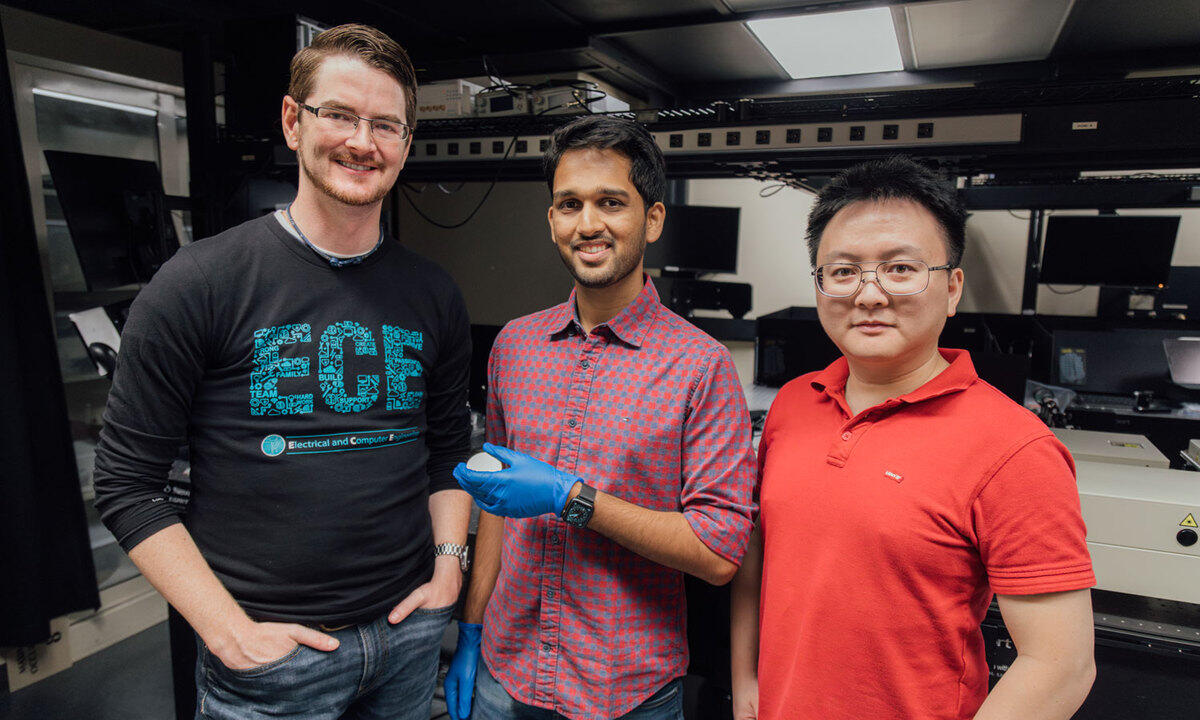
Aug. 30, 2023
VCU engineering professor helps light the way toward more powerful computing
Share this story
A Virginia Commonwealth University engineering professor is casting fresh light on a decades-old concept, one that could spur advances from national defense to driverless cars and telecommunications.
Nathaniel Kinsey, Ph.D., Engineering Foundation Professor in VCU’s Department of Electrical and Computer Engineering, is leading a group of researchers who are exploring frontiers in optical computing and machine learning. With a focus on nanophotonics, he studies the interaction of light with materials on the smallest of scales.
Though the concept of optical computing is not new, interest and funding waned in the 1980s and 1990s as silicon chip processing proved to be more cost-effective. But recent slowdowns in scaling silicon-based technologies have opened the door to revisiting methods of data processing.
“Optical computing could be the next big thing in computing technology,” Kinsey said. “But there are plenty of other contenders, such as quantum computing, for the next new presence in the computational ecosystem. Whatever comes up, I think that photonics and optics are going to be more and more prevalent in these new ways of computation.”
First, a quick link between man and machine: A neuron is a brain cell that helps humans think, and in the same vein, an artificial neural network helps machines learn – for example, it’s what helps Siri understand and answer our prompts. One of the powerful components of a neural network is the perceptron, and Kinsey is looking to use light (optical signals) instead of traditional digital processing (electrical signals) to create the component. His work on “nonlinear optical perceptrons” has drawn funding from the Air Force Office of Scientific Research, and the Defense Department sees optical computing as a promising step forward in military imaging.
“Let’s say you want to find a tank within an image,” Kinsey said. “Using a camera to capture the scene, translate that image into an electrical signal and run it through a traditional, silicon-circuit-based computer processor takes a lot of processing power – especially when you try to detect, transfer and process higher-pixel resolutions. With the nonlinear optical perceptron, we’re trying to discover if we can perform the same kinds of operations purely in the optical domain without having to translate anything into electrical signals.
“Elimination or minimization of electronics has been a kind of engineering holy grail for a number of years,” Kinsey added. “For situations where information naturally exists in the form of light, why not have an optical-in and optical-out system without electronics in the middle?”
Linear optical systems, like photonic integrated circuits that are common in fiber-optic communications, use limited energy but are not capable of complex image processing. Building nonlinear optical systems would expand functionality, making them ideal for remote sensing platforms on drones and satellites – for example, to identify tanks or troop movements as part of an early warning system. Kinsey’s research seeks to determine the impact of the additional power requirements in nonlinear optical computing.
There are potential nonmilitary applications as well, even if consumer applications might be years away. In driverless cars, optical computing could enhance LiDAR – the light detection and ranging equipment that tracks obstacles and helps maintain safe distances. For microbiologists, dark-field microscopy could be improved for examining clinical samples. In telecommunications, optical neural networks could read address labels and send data packets without electronics.
As part of the research, Kinsey and collaborators from the National Institute of Standards and Technology – they include Dhruv Fomra, one of Kinsey’s former Ph.D. students at VCU – are working to design a new kind of optically sensitive material. Their goal is to engineer and produce a device combining a unique material, called epsilon-near-zero, and a nanostructured surface to offer improved control over transmission and reflection of light – and with limited energy requirements, as the light is bent and shaped along the surface to perform data processing.
Kinsey used the example of putting a black plastic sheet outside on a sunny day. The heat changes its refractive index, a measure of its ability to bend light.
“That’s because the object is absorbing various wavelengths of light,” he said. “Now, if you design a material that is orders of magnitude more complex than a sheet of black plastic, we can use this change in refractive index to modify the reflection or transmission of individual colors – controlling the flow of light with light.”
Subscribe to VCU News
Subscribe to VCU News at newsletter.vcu.edu and receive a selection of stories, videos, photos, news clips and event listings in your inbox.







